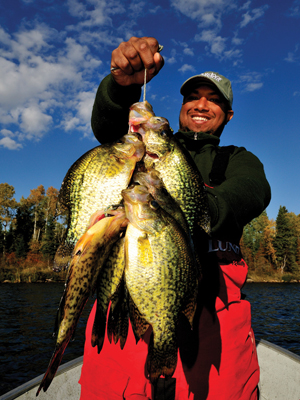Advertisement
Species: Bass, Crappie, Muskellunge, Perch, Pike, Sturgeon, Trout, Walleye/Pickerel, Whitefish
Season: Year-round
Advertisement
Coordinates: 49°14′59″N 94°45′03″W
Location: Northwestern Ontario
Surface area: 4,348.6 square kilometres
Advertisement
Hottest spot: Tranquil Channel
Why we chose it:
In 2012, ranked #4 in all-time hot spots
Advertisement
What can you catch on northwestern Ontario’s Lake of the Woods? Practically whatever you feel like. Covering one million acres, with 100,000 kilometres of shoreline (that’s more than Lake Superior) and dotted with 14,000 islands, it’s no wonder this huge, pristine lake has such fabulous fishing. Still, the variety, size and numbers continue to amaze. In fact, this 10-time hot spot could well be the world’s best water for walleye, muskies, crappie and several other species.
In 2011, Best for multiple species
Having lived on her shores for almost 40 years now, I have to say northwestern Ontario’s Lake of the Woods is in my soul. The massive sweetwater lake, tucked along the Manitoba and Minnesota borders, offers more than 100,000 kilometres of shoreline to explore thanks to some 14,000 islands. And swimming beneath the surface are more than 47 species of fish, from gigantic lake sturgeon and huge northern pike to plate-sized crappies and jumbo yellow perch.
Many contend Lake of the Woods is the finest walleye fishery in the world, while others make the same claim for her crappies—my biggest was a two-and-a-half-pound trophy. But why stop there? It was within sight of the boat launch in downtown Kenora, for example, that I caught my biggest muskie, a 57½-pound whopper. And it was on Lake of the Woods that I hooked my biggest winter lake trout, a 50-pound-plus goliath, before she snapped my line as if it were thread.
As for the bass, I’ve caught largemouth topping six pounds and so many four-pound-plus smallies I’d need a calculator to keep count. And the pike are so plentiful they bite off your lures when you’re casting for other species—my biggest northern so far was 50 inches long. A good day of jigging for whitefish in the winter, meanwhile, will see more than 100 fish caught and released. Enough said.
Hot lure: Jig and minnow
Hot fly: Black Bunny Leech
—Gord Pyzer
In 2010, Best for walleye; Great Numbers of decent size fish.
When to go: All season long
Where to fish: Rocky points, gravel beds and deep weedlines all produce.
Tip: Try jig-and-plastic combos, crankbaits, drop-shotting and drift jigging
—Mike Asher, a manager at Cabela’s Canada in Winnipeg.
Muskie; A trophy-class fishery with great numbers of fish
When to go: The entire season
Where to fish: Fish rock points, reefs, sunken humps, saddles and current areas
Tip: Cast big bucktail spinners and Top Raiders, or twitch eight-to 10-inch Jakes or Grandmas. Later in the season, troll 10- to 14-inch stickbaits, deep-diving cranks and Believers
—Mark Melnyk, host of the World Fishing Network’s Reel Road Trip
In 2009, Muskie; One of the best muskie lakes in Canada, with lots of structure that big fish prefer; 50-plus-inchers are not uncommon
When to fish: Mid-July through mid-September is prime.
Where to fish: Focus on rocky or weedy points and underwater structure in Whitefish and Sabaskong Bays.
Tip: Cast large bucktail spinnerbaits or jerkbaits, or try topwaters on calm evenings.
—Roger Cannon, past-president at Normark Canada
In 2008, Pike; Lots of action and the potential for 40-plus-inchers
When to fish: Fall.
Where to fish: Saddles between islands and rocky points.
Tip: Use big baits, and vary the speed of your presentation until you find the right one.
—Cam Brownson, host of The Angler & Hunter
Muskie; Outdoor Canada’s fishing editor, Gord Pyzer, has personally shown me what a world-class muskie fishery this is
When to fish: Late fall is best for the biggest fish.
Where to fish: Bottlenecks between points and islands, and around points and shoals.
Tip: Cast or troll big in-line spinners.
—Bob Izumi, host of Bob Izumi’s Real Fishing Show
Lake trout; Good numbers of six- to 18-pound fish, great scenery and comfortable lodging
When to fish: The first six weeks after ice-out.
Where to fish: Large, 12- to 25-feet-deep mud flats, bays, rocky shorelines adjacent to deep water and points.
Tip: Troll or quickly retrieve large spoons, crankbaits and herring-teaser rigs, or cast Bionic Bucktail Jigs tipped with soft-plastics.
—Steve MacInnis, host of Adventures North
Learn more: Lake of the Woods Experience

